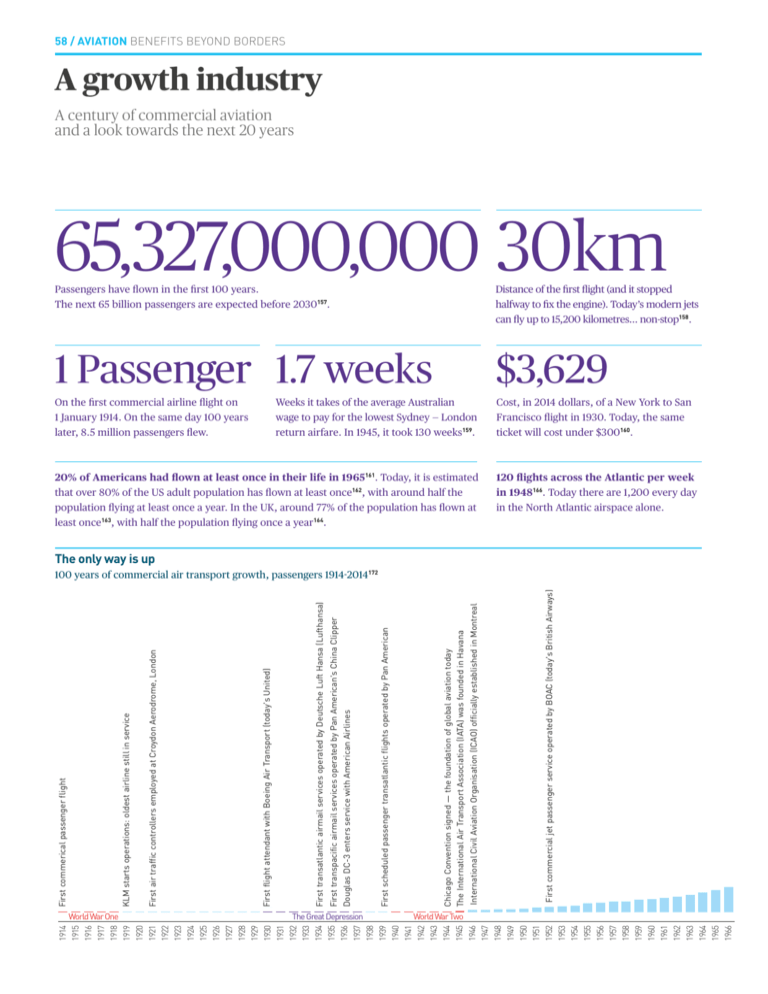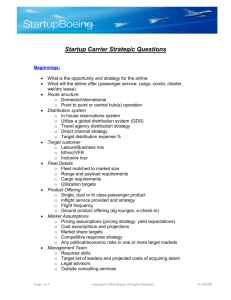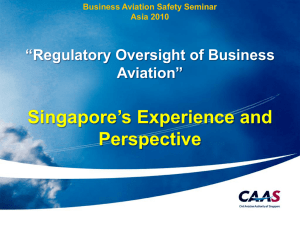65,327,000,000 30km - Aviation: Benefits Beyond Borders
advertisement

58 / AVIATION BENEFITS BEYOND BORDERS A growth industry A century of commercial aviation and a look towards the next 20 years 65,327,000,000 30km Passengers have flown in the first 100 years. The next 65 billion passengers are expected before 2030157. Distance of the first flight (and it stopped halfway to fix the engine). Today’s modern jets can fly up to 15,200 kilometres… non-stop158. 1 Passenger 1.7 weeks $3,629 On the first commercial airline flight on 1 January 1914. On the same day 100 years later, 8.5 million passengers flew. Cost, in 2014 dollars, of a New York to San Francisco flight in 1930. Today, the same ticket will cost under $300160. Weeks it takes of the average Australian wage to pay for the lowest Sydney — London return airfare. In 1945, it took 130 weeks159. 20% of Americans had flown at least once in their life in 1965161. Today, it is estimated that over 80% of the US adult population has flown at least once162, with around half the population flying at least once a year. In the UK, around 77% of the population has flown at least once163, with half the population flying once a year164. 120 flights across the Atlantic per week in 1948166. Today there are 1,200 every day in the North Atlantic airspace alone. The only way is up First commercial jet passenger service operated by BOAC (today's British Airways) International Civil Aviation Organisation (ICAO) officially established in Montreal Chicago Convention signed — the foundation of global aviation today The International Air Transport Association (IATA) was founded in Havana First scheduled passenger transatlantic flights operated by Pan American Douglas DC-3 enters service with American Airlines First transpacific airmail services operated by Pan American's China Clipper First flight attendant with Boeing Air Transport (today's United) First transatlantic airmail services operated by Deutsche Luft Hansa (Lufthansa) The Great Depression World War Two 1914 1915 1916 1917 1918 1919 1920 1921 1922 1923 1924 1925 1926 1927 1928 1929 1930 1931 1932 1933 1934 1935 1936 1937 1938 1939 1940 1941 1942 1943 1944 1945 1946 1947 1948 1949 1950 1951 1952 1953 1954 1955 1956 1957 1958 1959 1960 1961 1962 1963 1964 1965 1966 1967 1968 World War One First air traffic controllers employed at Croydon Aerodrome, London First commerical passenger flight KLM starts operations: oldest airline still in service 100 years of commercial air transport growth, passengers 1914-2014172 A GROWTH INDUSTRY / 59 “International civil aviation can greatly help to create and preserve friendship and understanding among the nations and peoples of the world.” — Preamble to the 1945 Chicago Convention 1919 Colombia Qantas 1920 Australia Aeroflot 1923 Russia Czech Airlines 1923 Czech Republic Finnair 1923 Finland Delta Air Lines 1924 United States Tajik Air 1924 Tajikistan Air Serbia 1927 Serbia Airports Council International (ACI) founded 47% In 1920, aircraft would spend 47% of the time in the hangar under repair167. 3.5b 3.26b 3b 2.5b 2b 1.5b 1b 0.5b Energy crisis Recession Gulf War 1 Asian financial crisis 9/11 SARS Financial crisis 0 0 Volcanic ash cloud 1964 1965 1966 1967 1968 1969 1970 1971 1972 1973 1974 1975 1976 1977 1978 1979 1980 1981 1982 1983 1984 1985 1986 1987 1988 1989 1990 1991 1992 1993 1994 1995 1996 1997 1998 1999 2000 2001 2002 2003 2004 2005 2006 2007 2008 2009 2010 2011 2012 2013 2014(F) Oil crisis Average passengers per aircraft in 1937 . Today, the average is around 100. 165 Passengers per year (billion) Avianca 6.5 First passenger biofuel flight by KLM The Netherlands Airbus A380 enters service with Singapore Airlines 1919 First frequent flyer programme launched by American Airlines KLM United States deregulated its airline industry Country Concorde enters service as first supersonic passenger aircraft Year The Boeing 747 enters service with Pan American First low cost carrier, Southwest Airlines, enters service Airline First transpolar passenger flight by Cathay Pacific 10 oldest airlines still in operation Civil Air Navigation Services Organisation (CANSO) founded Still going strong 60 / AVIATION BENEFITS BEYOND BORDERS A growth industry 1937 Early reach Map of the world’s air routes in 1937173 The past... The world’s first regularly scheduled heavier-than-air airline, the St Petersburg – Tampa Airboat Line, connected the towns of St Petersburg and Tampa in Florida with a 30 kilometre flight across the Tampa Bay. The airline was the creation of a local electrical engineer, Percy Fansler. He enlisted the support of Thomas Benoist, an early aircraft manufacturer who provided the plane and the pilot, Tony Jannus. On 1 January 1914, 3,000 people gathered at the waterside in St Petersburg to see the first flight of this fledgling airline. This was a huge crowd for the city considering that the permanent population was perhaps 7,000 people at the time. In a charity auction, former St Petersburg mayor Abram C. Pheil bid $400 for the privilege of being the first passenger. Normally passengers on the airline paid $5 (around $115 today) for the 23 minute flight. Invited to say a few words just prior to takeoff, Percy Fansler commented, “The airboat line to Tampa will be only a forerunner of great activity along these lines in the near future…what was impossible yesterday is an accomplishment of today — while tomorrow heralds the unbelievable”168. He was right. Transport has often been a driver of development throughout human history. The overland silkroad was replaced with new technology in the form of ships. Rail services replaced horse and cart and were in turn partially replaced by the automobile. And aircraft, in the early 20th Century, started opening up new routes and opportunities around the world. It is telling that even from the start, buoyed by the colonial and trading interests of European powers, air transport had a reach extending to all parts of the world. The map above shows the reach of air services in 1937, with routes throughout China, South-east Asia, Africa and Latin America. But it was when the first widebody jets were introduced in the 1960s that air transport really became the global force that helped shape the world. The opening up of tourism destinations and the use of this modern (and fast) transportation form allowed greater numbers of people to travel for business and leisure than ever before. The airline sector has never been an easy business. That very first airline flying across Tampa Bay only lasted five months and never broke even (although getting close). And it is telling that of the 19 airlines that were members of the Air Transport Association of America in 1937, only three survive today: American, Delta and United169. However, the significant growth in air transport has also seen significant increases in efficiency by the industry. In 1942, for example, there was an average of 86 passengers per airline employee in the United States170. Today, the global average is 1,310 passengers per employee. And what is today’s largest cost — fuel — has been a driver of efficiency gains from the earliest days of modern air transport. Through efficiency gains, airlines are today able to break even with fuel at over $100 a barrel, whereas they were making losses in 2003 when fuel was at $30 a barrel171. The restructuring of many airlines and streamlining of their operations has brought significant efficiencies. The profitability of airlines remains a challenge, but the industry is one which also shows remarkable resilience. Despite A GROWTH INDUSTRY / 61 2014 We fly everywhere Map of the world’s air routes today174 massive security and energy shocks and a series of hijackings in the 1970s, traffic continued to rise. Despite a tumultuous last couple of decades, with financial crises, health scares and conflicts hitting the industry (sometimes directly, in the case of 9/11), the growth trend has continued. Now, the growth is mainly taking place in the emerging economies of the world which are beginning to enjoy the benefits of travel as middle classes develop. … and the future 2012 2.97 billion The contribution of the air transport industry in 20 years’ time 2032 6.63 billion 175 passengers 5.4 trillion 12.2 trillion passenger kilometres flown 20,101 41,240 jet aircraft in service Air transport is forecast to support 103 million jobs by 2032 58.1 million 103.1 million jobs supported $2.4 trillion economic impact $5.8 trillion Several aircraft manufacturers, including Airbus, Boeing, Bombardier and Embraer, estimate the future demand for air transport in the form of revenue passenger kilometres. The most recent estimates176 suggest that demand for air transport will increase by an average of 4.7% per annum over the next 20 years. That implies that demand for air travel will increase by a factor of two and a half over the period. If this growth path is achieved, then in 2032 the air transport industry will contribute177: »» 13.9 million direct jobs and $1.4 trillion of GDP to the world economy; »» Including indirect and induced contributions, 36.7 million jobs and $3.8 trillion in GDP; »» Once the impacts of global tourism are taken into account, a total of 103 million jobs and $5.8 trillion in GDP. 62 / AVIATION BENEFITS BEYOND BORDERS A growth industry Through the ages 5 The impact of lower growth: a sensitivity analysis As a result of any number of unexpected events, demand for air transport over the next 20 years may diverge from current expectations. How would the economic contribution of aviation change if global demand for air transport proves to be lower than expected? A sensitivity analysis can help to answer this question. By changing key assumptions driving the results, this type of analysis can indicate a reasonable range for alternative outcomes. For example, if the average annual growth in passenger numbers for each region covered in this report turns out to be one percentage point lower than currently expected between 2012 and 2032, then in 2032: »» Worldwide, there would be 1.4 million fewer direct jobs in the air transport sector. »» Taking into consideration the direct, indirect, and induced impacts, there would be 3.7 million fewer jobs supported by air transport. »» Once the impacts of tourism are included, the air transport sector would support 1 2 6 7 a total of 12.4 million fewer jobs than would otherwise be the case under the baseline scenario. »» Worldwide, the direct, indirect, and induced GDP for air transport would be $661 billion (2012 prices) lower than it otherwise would be. »» An additional $352 billion would be lost because of a reduction in tourism activity. Aircraft in 2032 and beyond Despite the rapid rate of growth in passengers and aircraft movements from 2010 to 2032, the industry is confident that its emissions reduction targets will see a capping of net CO2 emissions from aviation in 2020. For the next target — reducing aviation CO2 to half of what it was in 2005 by the year 2050 — the industry will have to tap into its long history of innovation. Sustainable, advanced-generation aviation biofuels will certainly play a large role in reducing emissions. Operational and infrastructure improvements will also be an important building block. But new aircraft technology is going to be one of the most visible signs of that progress. Aerodynamicists are currently exploring new aircraft designs for the future. By some measures, the most efficient aircraft model is a ‘blended wing’ design where the entire aircraft becomes a lifting device, effectively a flying wing. Super lightweight materials and new systems will be required to implement the concept. The ‘Very Efficient Large Aircraft’ project has already researched blended wing concepts which would deliver per-seat fuel consumption improvements of up to 32% over current aircraft designs178. How these aircraft could be designed to fit into current airports and how passengers may react to a windowless journey, however, are subjects for further research. In late 2010, NASA awarded contracts to three teams — from Lockheed Martin, Northrop Grumman and Boeing — to study advanced concept designs for aircraft that could take to the skies in the year 2025. Each design looks very different, but all final designs have to meet NASA’s goals for: less noise; cleaner exhaust; lower fuel consumption; to fly up to 85% of the speed A GROWTH INDUSTRY / 63 SKILLS DEVELOPMENT Airports are catalysts to economic growth 3 4 8 8 of sound; cover a range of approximately 7,000 miles; and carry between 50,000 and 100,000 pounds of payload, either passengers or cargo. Each aircraft has to be able to do all of those things at the same time, which requires a complex dance of trade-offs between all of the new advanced technologies that will be on these vehicles179. Airbus has provided a glimpse into the future with its Concept Plane — the result of brainstorming between engineering and design staff as to the most efficient potential technologies and materials for aircraft construction. Even if these concept aircraft don’t eventually fly, research into these designs is producing a lot of the valuable innovation needed to produce the next generation of aircraft and helps the debate on decisions that must be made about environmental priorities. is the world’s oldest airline, celebrating 1 KLM its 90th year of operation in 2014. first flight attendants joined Boeing Air 2 The Transport in 1930. couple dines on the Lockheed Super 3 A Constellation in the mid-1950s. The cost of tickets was prohibitive to all but the very wealthy and should be compared to today’s first class in service and price. class film on board a Boeing 707 in 1965. 4 First The first film to be shown on board a flight was in 1921 on Aeromarine Airways in Chicago. Boeing 747 rolls out in February 1969. 5 The This, the first ‘jumbo jet’, revolutionised the airline industry and opened up travel possibilities for much larger segments of the population. and British manufacturers Aérospatiale 6 French and British Aircraft Corporation joined forces in the late 1960s to develop the world’s first successful commercial supersonic aircraft – Concorde – which flew for 27 years. Airbus consortium’s first commercial 7 The aircraft, the A300, entered service in 1974. the future, aircraft may start taking on different 8 In appearances as manufacturers investigate even more fuel efficient designs. Boeing’s Sugar Volt and the Airbus Concept Plane are two of the many visions of the future. Airports are more than just vital parts of the global transport system, linking communities and businesses with the world — they are important employers and catalysts to skills development in their own right. Ecuador’s New Quito International Airport, which opened in February 2013, has become one of the country’s most important infrastructure projects in terms of technological development, economic growth and employment generation. Recent estimates suggest it has generated around $1 billion in economic activity for the country and currently employs about 6,000 people across the different companies directly related to airport activity. Ecuador is one the largest flower exporters in the world and there are about 560 flower-growing farms around Quito aiming to sell their produce to the world market. During the peak flower-producing season of San Valentine in February 2014 there was an increase of 23.7% in air cargo throughput over 2013 as a result of new, larger aircraft being able to access the airport. During construction between 2006 and 2012, around 4,000 Ecuadorian workers and 120 local companies were contracted. The airport management company, as part of its development plan, launched a series of scholarship programmes, including the David Cachago Scholarship award which has seen 358 educational scholarships given to vulnerable young people. It has also formed new links with local businesses. These include helping Pimienta Gourmet — a small enterprise formed by local women — offer catering services to companies based at the airport, and setting up a database of local workers and small companies whose services could be needed by businesses based at the airport.






